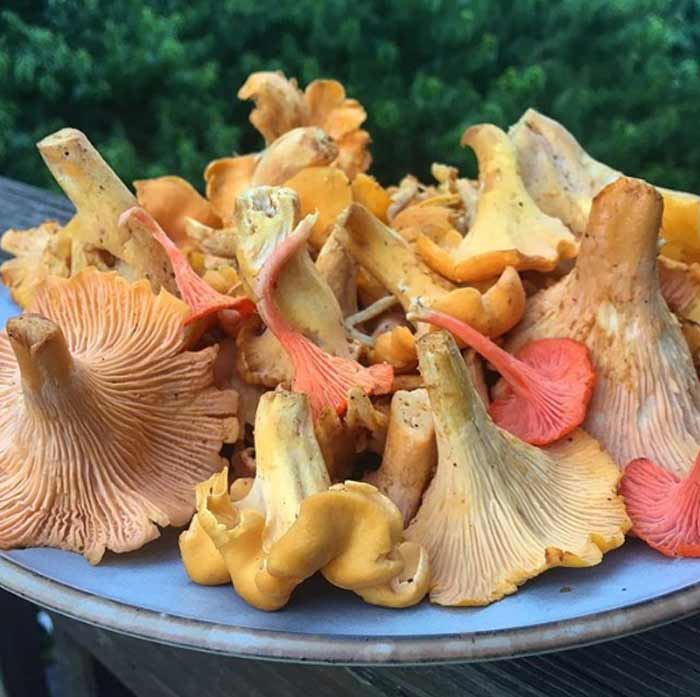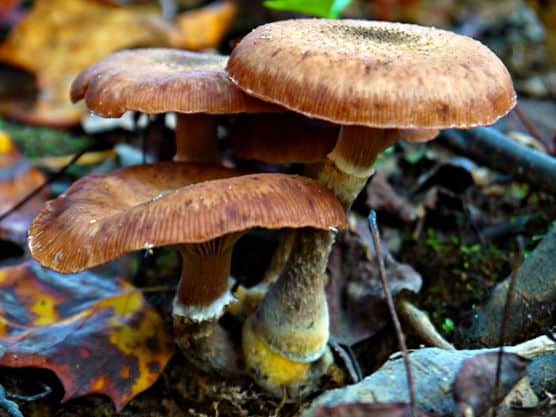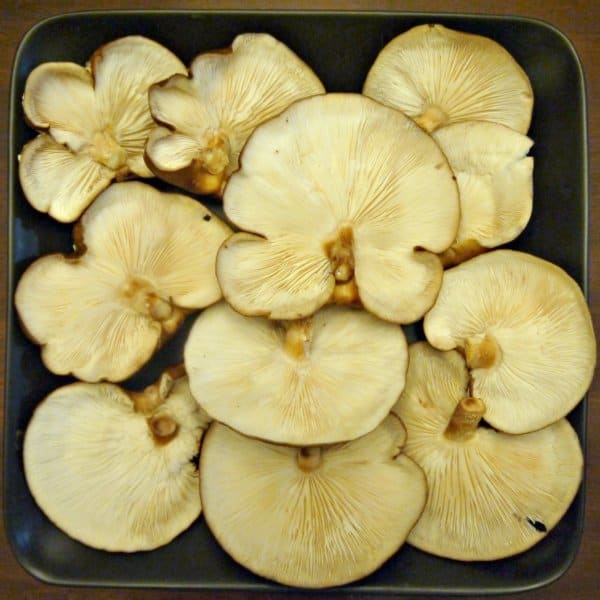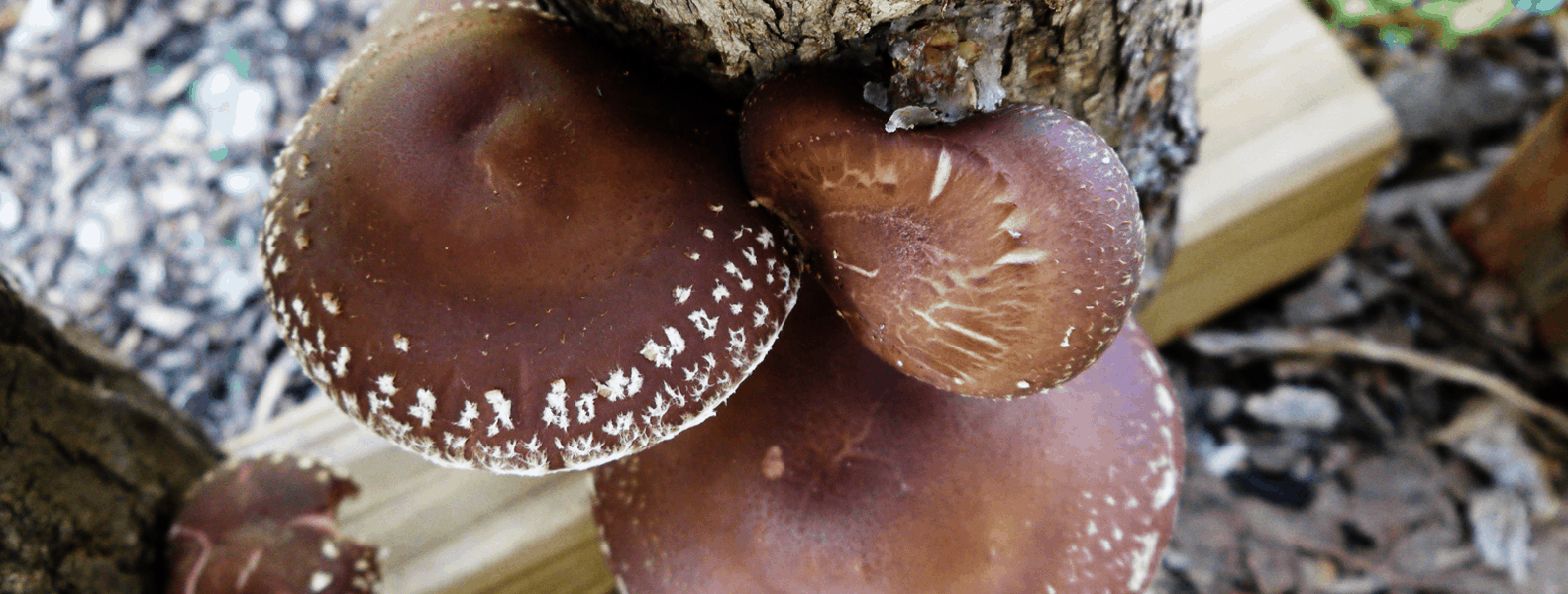This simple, step-by-step guide will show you exactly how to grow shiitake mushrooms — a delicious gourmet mushroom with scientifically proven health benefits.
Fight Cancer, Harvest Sunlight to Produce Your Own Vitamin D, and Boost Your Immune System… all by learning how to grow shiitake mushrooms!
You may have noticed from our Instagram photos and other articles, that The Tyrant and I love mushrooms. That wasn’t always the case.
We used to think that mushrooms were just the bland white button variety (Agaricus bisporus) that we saw in the grocery store. The only other mushrooms we knew about were portobellos, which are actually just a more mature white button mushroom (yep, Agaricus bisporus too).
An introduction to a whole new world of gourmet mushrooms
That all changed in 2010 when we got to know mycologist (mushroom scientist) Tradd Cotter. Since then, we’ve steadily grown in our knowledge of and passion for gourmet, medicinal mushrooms. Today, we grow our own mushrooms and wild-forage mushrooms as well.
As a result, we know that there are seemingly infinite varieties of delicious edible mushrooms that come in every imaginable size, shape, color, and flavor.

Gorgeous chanterelle and cinnabar mushrooms from a summer forage in the woods.
Some of our favorite mushrooms range in taste from the fruity & nutty chanterelles to maple syrup flavored parasols to savory & sublime morels.
And, just to give you a proper appreciation for the size that mushrooms can grow, the largest living organism on earth, is a 4 mile wide edible honey mushroom!

Fruiting Honey mushrooms in the woods behind our home.
Learn the Safety Rules Before You Start Foraging and Eating Mushrooms
Unless you live in the desert, chances are there are many edible mushroom varieties that grow wild in your yard or nearby woods.
Just as you shouldn’t get behind the wheel of a car without proper training/education, you should NEVER eat a mushroom (or anything else) that you’re not 100% sure you’ve correctly ID’d. Doing so could result in extreme illness or a slow and painful death.
Scared? Good!
Instead of letting your healthy fear of mushrooms keep you off of the mushroom “road” forever, why not just learn how to drive safely and then enjoy all the places these wonderful organisms will take you?
If you’re still not convinced that you should consider getting your “driver’s license” in mushrooms, you might be further swayed by knowing that many varieties of mushrooms have incredible medicinal benefits: they’re antiviral, antimicrobial, anticancer, antihyperglycemic, cardioprotective, and anti-inflammatory.
Want to keep reading? Good!
Mycorrhizal mushrooms
Many of our favorite gourmet mushrooms can’t be commercially cultivated since they are “mycorrhizal,” i.e. they form symbiotic relationships with the roots of plants.
Mycorrhizal mushrooms vastly expand the reach of a plant’s root system to help it draw in additional water and nutrients. In return, the plants provide the mushrooms with a constant source of carbohydrates via glucose and sucrose. It’s estimated that 95% of all plants are mycorrhizal.
So, when you’re walking through the woods and you see mushrooms, you’re seeing a very small portion of the actual organism — the visible fruiting body. Meanwhile, a massively complex, interconnected web of organisms are dancing invisibly underneath your feet.
A mushroom is to its fungal body what an apple is to a tree. Isn’t nature cool?
The Easiest Mushrooms to Grow At Home
Not all mushrooms are mycorrhizal. Many of the best edible mushrooms in the world can easily be cultivated without needing living tree roots to associate with.
At Tyrant Farms, we’re currently growing oyster, shiitake, king stropharia, chicken of the woods, and blewit mushrooms, not to mention at least 15 native edible varieties we’ve enjoyed from our lawn and/or the woods behind our home that were here long before we were.

A delicious and very hard to find umbrella polypore.
This particular article is about a revered Asian delicacy with a wide range of medicinal properties to boot: the shiitake mushroom.
We’ve had some beautiful shiitake harvests over the years, and wow are they a delicious mushroom. As such, we wanted to let you know how to grow shiitake mushrooms, too!
Another cool DIY trick we’ll teach you below: you can supercharge your shiitake mushrooms with extra Vitamin D before eating them.
Keep reading to find out how!
DIY: How to Grow Shiitake Mushrooms

A beautiful cluster of shiitake mushrooms from our logs. These are gill-side up and ready to be charged with Vitamin D in the sun.
The shiitake growing instructions below are very detailed, so they may look complicated at first glance. However, learning how to grow shiitake mushrooms is actually quite simple.
For reference, think about how complicated instructions for making a peanut butter & jelly sandwich look when you see them in writing. Same thing here, so don’t be intimidated!
I. How to Grow Shiitake Mushrooms: MATERIALS LIST
Here’s the materials you’ll need to grow shiitake mushrooms in logs:
- 100 inoculated shiitake mushroom plugs. You can buy shiitake plugs here. We grow both warm weather and cool weather shiitakes so that we can get fresh shiitake mushrooms throughout the year.
- Two (2) recently cut hardwood tree sections with bark still on. These should be 4-8 inches in diameter and 3-4 feet long. Thick barked hardwoods such as oaks & poplars are ideal. To make more shiitake logs, get more shiitake mushroom plugs at the same ratio (roughly 50 plugs per 6″ diameter x 4′ long log).
- High speed/power drill with a multi-purpose 5/16″ drill bit. If you want to get more serious and do a lot of logs, you’ll probably want to upgrade to an angle grinder with specialized high speed adapter as you can see here.
- Rubber mallet (or hammer but mallet is better) for tapping the mushroom plugs into the holes.
- Food grade wax, some beeswax or cheese wax for sealing your mushroom plugs in the log. Note: canning wax isn’t ideal because it becomes really brittle and can fall off leaving your logs open & exposed to being colonized by other mushrooms.
- Old junk can for melting your wax.
- Camping stove or other heat source for melting wax in can. We just use our stove top and reheat the wax as necessary.
- Small paint brush for applying wax.
II. How to Grow Shiitake Mushrooms: STEP BY STEP GUIDE
1. Inoculate your shiitake logs in the warm months, ideally spring.
If you inoculate your shiitake logs in the middle of winter when it’s below freezing out, the spawn won’t be very active. The ideal time to inoculate shiitake logs is after freezing weather has passed in the spring.
You can continue to inoculate your shiitake logs throughout the warm months up until a couple months before your first freeze.
2. Order Your Shiitake Mushroom Plugs
Once you’ve got your logs identified or cut, go ahead and order your shiitake mushroom plugs. Again, 100 shiitake plugs is enough to do two, 6″ diameter logs that are 3-4′ long. If you have more logs, order more shiitake plugs.
If you can’t use your shiitake plugs within a week of arrival, stick them in the fridge for up to 6 months.
3. Cut hardwood tree sections or source just-cut hardwood logs.
Select two suitable living hardwood tree sections or tree branches that are 4-8 inches in diameter and 3-4 feet long. Oak is ideal, but other hardwoods are fine too.
100 mushroom plugs will adequately inoculate two logs with the above dimensions.
We used to recommend letting your logs “cure” for 2-4 weeks in a shaded, dry environment off of the dirt or forest floor (like a garage or shed floor). That’s because healthy, living trees have anti-fungal agents in their sap, so 2 weeks allows time for these compounds to dissipate.
However, our mycologist friend who originally made that recommendation to us years ago now says that he inoculates his logs immediately after cutting. Apparently, the mushroom spawn will “hang out and wait,” then start to inoculate the logs as soon as the wood’s anti-fungal compounds break down.
The longer you let your logs sit without inoculating them with your shiitake mushroom plugs, the more time you give fungal spores from other species to land on your logs and start to grow.
So don’t wait more than one month before inoculating your logs or your mushrooms will likely have increased competition.
4. Drill Holes In Your Shiitake Mushroom Logs
Use a power drill with a 5/16″ drill bit attachment to drill offsetting, parallel rows of holes in each log. This should look like a diamond pattern.
Each hole should be about 1 1/4″ deep and no more than 3-4″ apart.
Ideally on a 3ft log, you should have 50 holes per log. On a 6ft. log, you should have 100 holes. We prefer the shorter 3ft logs because they’re much easier to carry and move.
5. Insert Your Shiitake Mushroom Plugs Into Logs
Time for mushroom surgery! Wash your hands to make sure you’re not infecting your shiitake plugs with any competing fungi.
In a shaded area, separate your plugs into two piles of 50 plugs (assuming you’re using 3ft logs). Put the plugs on a clean surface, like a washed plate or a ziplock bag.
Put your logs on newspaper or plastic if you don’t want melted wax on the floor/ground. Insert your shiitake plugs into each hole. Immediately tap them in with your rubber mallet or hammer.
Make sure each shiitake plug is well set into the hole so that the surface of the plug is at or below the surface level of the log.
Don’t leave any drilled holes empty! If needed fill any empty holes with wax, or another species of mushroom will take hold there.
6. Melt and Apply Wax to Your Shiitake Logs
On a stove top, grill, or camp stove, heat your wax until fully melted.
Using a cheap paint brush, seal each cut end of the log completely with melted wax. Next, seal each hole thoroughly with wax so that each shiitake plug has its own tight little “house,” safe from other competing fungi that might come knocking.
7. Incubate Your Shiitake Logs for 6-12 Months
Place your shiitake logs in a shady, moist location off of the ground but within reach of a garden hose. You don’t want too much sunlight to hit the logs, and you don’t want the logs touching the ground, which encourages other competing fungi to come aboard.
An old palette, bricks, or concrete blocks are good for this purpose. Ideally, you can also cover your logs with a breathable cloth (such as a shade cloth or weed blocker) to help keep out sun while allowing moisture to come through, Don’t use plastic since this will make your logs mold!
Once you have your logs stored, it’s time to think about their water needs…
- Wet climate – If you live in a moist climate like we do, you can water your shiitake logs once per week for about 10 minutes during a dry week in which it doesn’t rain. If you get a good soaking rain, don’t worry about watering them).
- Dry climate – If you live in a dry/arid climate, you should plan to water your logs twice per week for 10+ minutes each time. Don’t water your logs if the outside temps are below freezing as this can cause your logs to split or loose their bark.
To help remember to water your shiitake logs, we recommend setting up a recurring calendar event with an alert so that your technology can help you take care of your biology.
8. When Ready, “Initiate” Your Shiitake Logs
Under ideal conditions, your shiitake logs will be ready to fruit after 6 months, but it’s recommended that you wait at least 9-12 months before “initiating” them. “Initiating” them means forcing them to fruit and produce mushrooms.
It takes a lot of energy for the shiitake colony to produce mushrooms (like having a baby). Waiting to initiate them ensures that the colony is really strong.
Your logs will do a pretty good job of telling you when they’re ready: keep an eye on the cut ends of the logs that you sealed with wax, and if the surface area looks dark and mottled, then you know the colony has taken over the log and is ready to fruit.
Sometimes, under ideal conditions, your logs will go ahead and fruit on their own without your help.
Once you’ve determined that your shiitake logs are ready to be initiated, you’ll want to submerge them in water for 24 hours. You can use a bathtub, a pail, a contractor bag, a natural (clean) body of water, or whatever else you can come up with that’s big enough.
Ideally, you can use non-chlorinated water (rain, spring, boiled tap water, creek, etc), but we’ve found that water straight out of the hose will work fine if that’s your only option.

Since we originally wrote this article, we’ve built our own backyard duck pond for our egg-laying Welsh Harlequin ducks. As you can see here, our duck pond makes an ideal spot to soak/initiate our shiitake mushroom logs – although our ducks might disagree! We usually soak our shiitake logs overnight so our girls can enjoy log-free swimming during the day.
After 24 hours of soaking, place your logs back in a shady area and in an upright, vertical position. This insures that when mushrooms start forming, they don’t get dirty.
You’ll see “primordia” (baby mushrooms) form sometime between 2-14 days. Make sure the shiitake logs stay moist during this waiting period by watering them 1-2 times per day for about 5 minutes each time.
Soon, your whole log will be covered with beautiful shiitake mushrooms! There’s not a “right” size to eat them—you can pick them when they’re small or let them get huge.
9. Harvest Sunlight to Boost Vitamin D, Then Cook & Eat Your Shiitake Mushrooms!
We learned an incredibly cool, simple technique courtesy of famed mushroom expert, Paul Stamets, that literally allows you to harvest sunlight to produce Vitamin D.
Vitamin D3 is produced from animals and used in most D vitamin supplements. Vitamin D2 is the type of D vitamin found in mushrooms and plants.
As Stamets says, “Vitamin D is an essential vitamin that boosts the immune system and plays vital roles in human metabolism.”
Vitamin D is incredibly good for you, and you need it regularly to stay healthy, especially in the northern hemisphere or during the fall, winter, and early spring when there is less sunlight, preventing your body from producing its own Vitamin D.
How to grow shiitake mushrooms and turn them into Vitamin D powerhouses:
Once you’ve harvested your shiitake mushrooms, put them in a sunny location gill side up for 24-48 hours.
This has been proven to drastically boost the shiitake’s natural Vitamin D2 levels from around 100 IU/100 grams to nearly 46,000 IU/100 grams!
Cooking with shiitake mushrooms
Now that you know how to grow shiitake mushrooms, we recommend you learn how to cook them! Not to worry.
There are infinite numbers of ways to cook your delicious and versatile shiitake mushroom. Just do a google search and start experimenting. We just made this easy shiitake mushroom green bean stir fry recipe courtesy of Jaden Hair over at Steamy Kitchen.
If you have too many shiitkae mushrooms to eat, don’t worry. Dry them and put them in an airtight container. Yes, the elevated Vitamin D levels will last for over one year – and you can also put dry shiitakes out in the sun gill-side up to charge back up!
We hope this How To Grow Shiitake Mushrooms Guide will inspire you to grow and enjoy your own shiitake mushrooms at home, year round!
Warning: Don’t ever eat anything that you can’t identify with 100% certainty. Also, it’s estimated that 1-2% of the population may experience an allergic reaction to mushrooms due to their body’s inability to digest them (they don’t have the necessary enzymes).
So, the first time you eat a shiitake or any other edible mushroom, just try a small amount. Wait 24-48 hours and if you haven’t experienced an allergic reaction, it’s safe to assume that your body is perfectly capable of digesting them.

More fun fungi articles you might enjoy:
- How to identify and use chanterelle mushrooms
- 6 gourmet and medicinal mushrooms you can easily grow in your garden
- How to find, identify, grow, and cook chicken of the woods mushrooms
- The hunt for the elusive morel mushroom
- How to find and prepare maitake mushrooms
- A delicious indigo milkcap recipe
Like what you're seeing here? Please be sure to subscribe to Tyrant Farms so we can let you know about new articles you'll love.

![[SHARE IMG] Shiitake How to Grow Shiitake Mushrooms - a step-by-step guide](https://cdn.statically.io/img/www.tyrantfarms.com/wp-content/uploads/2012/10/SHARE-IMG-Shiitake.png?f=auto)


7 Comments
Sarah
January 17, 2019 at 2:44 pmThanks for the detailed instructions. Approximately how much will each log produce? How long will they continue to produce?
Baz Daniels
January 17, 2019 at 2:44 pmThank you so much! I’m getting started now.
Cynthia
January 17, 2019 at 2:44 pmWhen you put your mushrooms in the sun to harvest vitamin D, how long do you leave them out and do you need to be concerned about animals bothering them?
Jonathan
October 24, 2013 at 6:25 pmHow long will your mushroom log keep producing fruit?
This sounds like something I am going to try out!
Susan
October 25, 2013 at 12:07 pmThey should produce for several years, but you can also capture the spore from your mushrooms and inoculate new logs with them to keep them going for as long as you want them. Sometimes that process happens accidentally too!
The Easiest Way To Make Your Solar Panels-Understand The Proper Way To Build Your Own Solar Panels
December 22, 2012 at 2:24 pm[…] way Feather Tresses ExtensionsA Review Of Solar Stirling PlantWho Says Calculators Can’t Be FunAn easy step-by-step DIY guide on how to grow shiitake mushrooms.Who Says Calculators Can’t Be FunAn easy step-by-step DIY guide on how to grow shiitake […]
The Easiest Way To Make Your Solar Panels-Understand The Proper Way To Build Your Own Solar Panels
December 22, 2012 at 2:24 pm[…] way Feather Tresses ExtensionsA Review Of Solar Stirling PlantWho Says Calculators Can’t Be FunAn easy step-by-step DIY guide on how to grow shiitake mushrooms.Who Says Calculators Can’t Be FunAn easy step-by-step DIY guide on how to grow shiitake […]